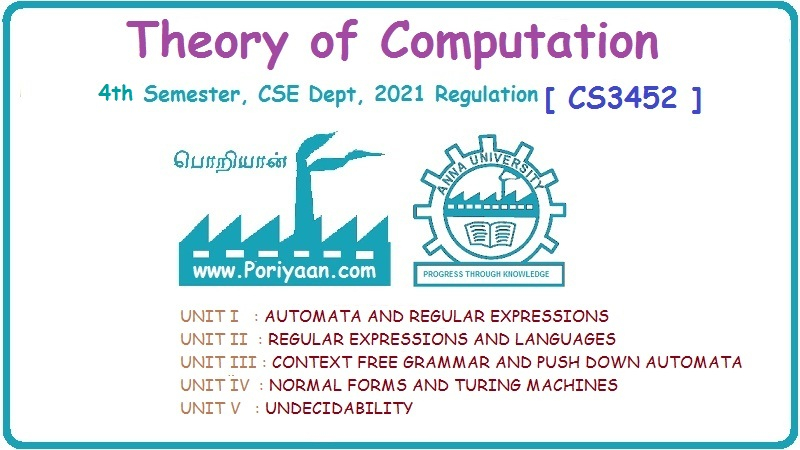Theory of Computation: Unit I: Automata and Regular Expressions
Deterministic Finite Automata (DFA)
Automata and Regular Expressions - Theory of Computation
The finite automata is called Deterministic Finite Automata if there is only one path for a specific input from current state to next state.
Deterministic Finite
Automata (DFA)
AU: Dec.-07, 10, 11, 13, 16, 19,
May-07, 14, Marks 13
The
finite automata is called Deterministic Finite Automata if there is only one
path for a specific input from current state to next state. For example, the
DFA can be shown in Fig. 1.6.1.

From
state S0 for input 'a' there is only one path, going to S2.
Similarly from S0 there is only one path for input b going to S1.
The
DFA can be represented by the same 5-tuples described in the definition of FSM.
Definition of DFA
A
deterministic finite automation is a collection of following things -
1)
The finite set of states which can be denoted by Q.
2)
The finite set of input symbols Σ.
3)
The start state q0 such that q0 ϵ Q.
4)
A set of final states F such that F ϵ Q.
5)
The mapping function or transition function denoted by δ. Two parameters are
passed to this transition function: One is current state and other is input
symbol. The transition function returns a state which can be called as next
state.
For
example, q1 = δ (q0, a) means from current state q0,
with input a the next state transition is q1.
In
short, the DFA is a five tuple notation denoted as :
A
= (Q, Σ, δ, q0, F)
The
name of DFA is A which is a collection of above described five elements.
Example 1.6.1
Design a FA which checks whether the
given binary number is even.
Solution:
• Logic:
The binary number is made up of 0's and 1's when any binary number ends with 0
it is always even and when a binary number ends with 1 it is always odd. For
example,
0100
is a even number, it is equal to 4.
0011
is a odd number, it is equal to 3.
• Design:
While designing FA we will assume one start state one state ending in 0 and
other state for ending with 1. Since we want to check whether given binary number
is even or not, we will make the state for 0, as the final state. (Refer Fig.
1.6.2)
Simulation:
The FA indicates clearly S1 is a state which handles all the 1's and
S2 is a state which handles all the 0's. Let us take some input.
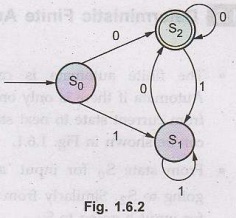
01000
=> 0S21000
01S1
000
010S2
00
0100S2
0
01000S2
Another
idea to represent FA with the help of transition table.
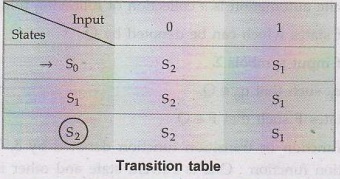
Example 1.6.2
Design FA which checks whether the given
unary number is divisible by 3.
Solution:
• Logic :
The
unary number is made up of ones. The number 3 can be written in unary form as
111, number 5 can be written as 11111 and so on.
The
unary number which is divisible by 3 can be 111 or 111111 or 111111111 and so
on.
• Design

• Simulation
Consider
a number 111111 which is equal to 6 i.e. divisible by 3. So after complete scan
of this number we reach to final state q3.
Start
111111
State
q0
1q1
11111
11q2
1111
111q3
111
1111q1
11
11111q2
1
111111q3
→ Now we are in final state.
Example 1.6.3
Design FA to check whether given decimal number is divisible by three.
Solution:
• Logic :
To
determine whether the given decimal number is divisible by three, we need to
take the input number digit by digit.
Also,
while considering its divisibility by three, we have to consider that the
possible remainders could be 1, 2 or 0. The remainder 0 means, it is divisible
by 3. Hence from input set {0, 1, 2, …. 9} (since decimal number is a input),
we will get either remainder 0 or 1 or 2 while testing its divisibility by 3.
So we need to group these digits according to their remainders.
The
groups are as given below -
remainder
0 group: S0: (0, 3, 6, 9)
remainder
1 group: S1: (1, 4, 7)
remainder
2 group: S2: (2,5,8)
We
have named out these states as S0, S1 and S2.
The state So will be the final state as it is remainder 0 state.
• Design:
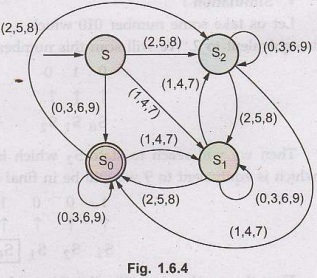
• Simulation:
Let
us test the above FA, if the number is 36 then it will proceed by reading the
number digit by digit.
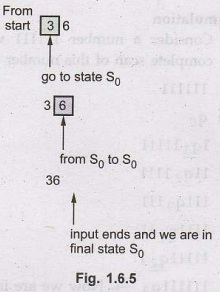
Hence
the number is divisible 3, isn't it ? Similarly if number is 121 which is not
divisible by 3, it will be processed as
S
121
1
S1 21
12
S0 1
121
S1 which is remainder 1 state.
Example 1.6.4
Design FA which checks whether a given
binary number is divisible by three.
Solution:
• Logic:
We
will consider the input digit by digit.
While
considering the divisibility by 3, we should think of three types of states, namely-
remainder
0 i.e. S0 state
remainder
1 i.e. S1 state
remainder
2 i.e. S2 state
• Design:

• Simulation:
Let
us take some number 010 which is equivalent to 2. We will scan this number from
MSB to LSB.
0 1 0
↑ ↑
↑
S0
S1 S2
Then
we will reach to state S2 which is remainder 2 state. Similarly for
input 1001 which is equivalent to 9 we will be in final state after scanning
the complete input.
1 0 0 1
↑ ↑ ↑ ↑
S1
S2 S1 S0
Thus
the number is really divisible by 3.
We
can also represent the simulation in following manner -
Consider
input 1001
S
Ⱶ 001
1
Ⱶ S1 001
10
Ⱶ S2 01
100
Ⱶ S1 1
1001
Ⱶ S0 i.e. ACCEPT state
Example 1.6.5
Consider the finite automata transition
table shown below with F = {q0}
AU: Dec.-10, Marks 10

Find the language accepted by the
finite automata.
Solution: The
transition diagram for the given transition table will be as shown in Fig.
1.6.7.
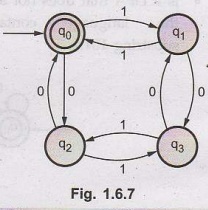
•
The sets accepted by this language are (0011, 00, 11, 1010, 0101, ... }
•
This shows that all the strings contain even number of 0's and even number of
1's. Hence the language accepted by this finite automata contains "all the
strings having even number of O's and even number of 1's".
Example 1.6.6
Design FA to accept L, where L = {Strings
in which a always appears trippled) over the set Σ = {a, b}. AU:
Dec.-10, Marks 10
Solution:
•
Logic: For this particular language
the valid strings are aaab, baaaaaa, bbaaab and so on. The a always appears in a clump of 3.
Note
that in Fig. 1.6.8 the sequence of tripple a is maintained to reach to the
final state.
• Design
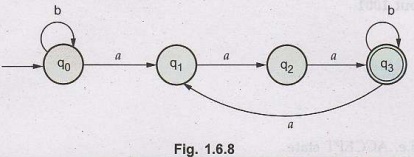
Example 1.6.7
Construct a DFA that accepts all the
strings on {0, 1} except those containing the substring 101.
AU: May-07, Marks 6, May-14, Marks
8
Solution :
•
The simplest method to construct such DFA is to construct DFA for the language
containing the substring 101.
•
Now just change the non-final states to final states and make final state as non-final
state. The DFA then becomes shown in Fig. 1.6.9.

•
is a DFA that does not accept the language containing substring 101.
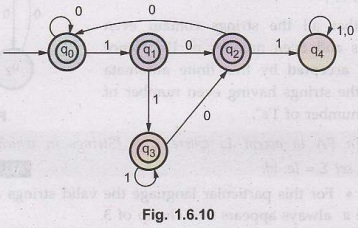
Example 1.6.8
Define DFA. Design a DFA to accept the
binary numbers which are divisible by 5.
Solution: i) DFA -
Refer section 1.6.
ii) DFA for divisibility by 5:
For designing DFA as a divisibility by 5 tester for a binary string we will
consider following states.
q0
- remainder 0 state
q1
- remainder 1 state
q2
- remainder 2 state
q3
- remainder 3 state
q4
- remainder 4 state
Now
we will design DFA by considering above states and finding next states with
input 0 and 1.
The
DFA will be

Simulation: Consider
the string (1111)2 = (15)10
q0
Ⱶ 1111
1q1
Ⱶ 111
11q3
Ⱶ 11
111q2
Ⱶ 1
1111q0
Ⱶ
Divisible
by 5. q0 is a final
state.
Consider
input string (1110) = (14) 10
q0
Ⱶ 1110
1
q1 Ⱶ 110
11
q3 Ⱶ 10
111
q2 Ⱶ 0
1110
q4 Ⱶ
Remainder
4. q4 is remainder 4
state.
Example 1.6.9 Draw transition diagram for
recognizing the set of all operators in C language. AU: Dec.-07, Marks 10
Solution:
•
Logic: In C language there are
various operators, such as relational operators bitwise operators and
arithmetic operators. Various relational operators are <, <=, >=, !=, ==. The bitwise operators
are &&, ||. Let us draw the transition diagram for these operators.
• Design:

Example 1.6.10
Construct a DFA accepting all string w
over {0, 1}, such that number of 1's in
w is 3 mod 4. AU: Dec.-11, Marks 8
Solution:
The DFA will be

Example 1.6.11
Give deterministic finite automata
accepting the following language over the alphabet.
1) Number of 1's is a multiple of
3.
2) Number of 1's is not a multiple
of 3. AU:
Dec.-13, Marks 8
Solution:
1) We assume alphabet as input set Σ = {1}

2)
For recognizing number of 1's not a multiple of 3, we will use the DFA in step
(1). That means we will make non final states as final and final state as
non-final ones. The DFA will then be as shown in figure.

Example 1.6.12
Given Σ = (a, b), construct a DFA which
recognize the language
L= {bm abn
:m,n>0}. AU Dec.-16, Marks 6
Solution:
•
The m and n are > 0 and there is no restriction on number of m and n. In
other words any number of m and n are allowed except null.
•
Hence we can rewrite given L as
L
= b+ ab+
•
From this L we can construct DFA as

Example 1.6.13
Construct a DFA to accept strings over
(a, b), such that every block of length five contains at least two a's. Use
extended transition of function to trace a string W = aabba.
Solution:
The following DFA contains block of five symbols. The DFA loops back when the
block ends. At each state both the a and b symbols are considered. The state
names indicate the total number of a's so far visited. For instance if the
state name is 1 then it indicates that there is single a being read. When two
a's are read then it leads to a final state. The DFA will be shown in Fig.
1.6.12.
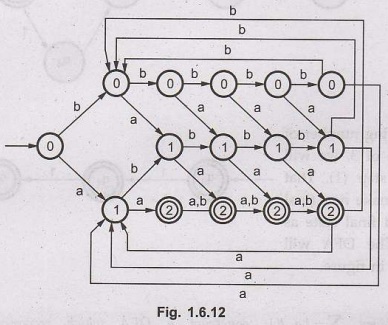
Example 1.6.14
Design a DFA which accept strings of O's
and 1's which when interpreted as a binary integer is multiple of 5. Also give
the sequence of states that DFA is in while processing the input string:
1001011.
Solution: The required DFA
can be drawn as follows.

Processing of 1001011
q0
Ⱶ 1001011
1
q1 Ⱶ 001011
10
q2 Ⱶ 01011
100
q4 Ⱶ 1011
1001
q4 Ⱶ 011
10010
q3 Ⱶ 11
100101
q2 Ⱶ 1
1001011
q0 Ⱶ Accept.
Example 1.6.15
Design a FA for following language
L = {W|W is Binary word of length
4i (where i >= 1) such that each consecutive block of 4 bits contains
atleast 2 0s} = {0000, 0110, 01101100, ...) AU:
Dec 19, Marks 13
Solution :

Theory of Computation: Unit I: Automata and Regular Expressions : Tag: : Automata and Regular Expressions - Theory of Computation - Deterministic Finite Automata (DFA)
Related Topics
Related Subjects
Theory of Computation
CS3452 4th Semester CSE Dept | 2021 Regulation | 4th Semester CSE Dept 2021 Regulation
